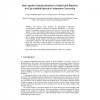Free Online Productivity Tools
i2Speak
i2Symbol
i2OCR
iTex2Img
iWeb2Print
iWeb2Shot
i2Type
iPdf2Split
iPdf2Merge
i2Bopomofo
i2Arabic
i2Style
i2Image
i2PDF
iLatex2Rtf
Sci2ools
TSD
2007
Springer
2007
Springer
Inter-speaker Synchronization in Audiovisual Database for Lip-Readable Speech to Animation Conversion
The present study proposes an inter-speaker audiovisual synchronization method to decrease the speaker dependency of our direct speech to animation conversion system. Our aim is to convert an everyday speaker’s voice to lip-readable facial animation for hearing impaired users. This conversion needs mixed training data: acoustic features from normal speakers coupled with visual features from professional lip-speakers. Audio and video data of normal and professional speakers were synchronized with Dynamic Time Warping method. Quality and usefulness of the synchronization were investigated in subjective test with measuring noticeable conflicts between the audio and visual part of speech stimuli. An objective test was done also, training neural network on the synchronized audiovisual data with increasing number of speakers.
Animation Conversion System | Audiovisual Synchronization Method | Lip-readable Facial Animation | Signal Processing | TSD 2007 |
| Added | 09 Jun 2010 |
| Updated | 09 Jun 2010 |
| Type | Conference |
| Year | 2007 |
| Where | TSD |
| Authors | Gergely Feldhoffer, Balázs Oroszi, György Takács, Attila Tihanyi, Tamás Bárdi |
Comments (0)

